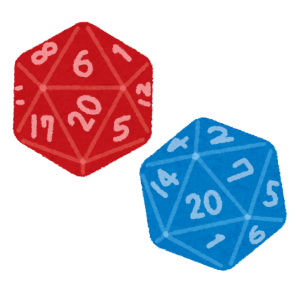Japanese Level 1, Activity #11: “Category Dice” / “カテゴリーさいころ” (Face-to-Face)

Image via: irasutoya
Students will practice asking and answering questions in full sentences by playing a board game. The game will focus on schedules, daily activities, and frequency adverbs.
Semantic Topics
Answer questions, ask questions, reading comprehension, listening comprehension, game, schedule, daily activities, frequency, full sentences, 質問に答える, 質問をする, 読解, リスニング理解, ゲーム, スケジュール, 毎日の活動, 頻度, 完全な文章, Xがあります/います, Describing Where Things Are, 物がどこにあるかを説明する, Past Tense of です, ですの過去形, Past Tense of Verbs, 動詞の過去形, も, 一時間, たくさん, と
Products: Daily Schedule, frequency words
Practices: Typical Daily Schedules
Perspectives: The importance of Punctuality
NCSSFL-ACT World-Readiness Standards:
- Standard 1.1: Students engage in conversation, provide and obtain information, express feelings and emotions, and exchange opinions.
- Standard 1.2: Students understand and interpret written and spoken Japanese on a variety of topics.
Idaho Content Standards for World Languages:
- COMM 1.1 – Interact and negotiate meaning (spoken, signed, written conversation) to share information, reactions, feelings, and opinions.
- COMM 2.1 – Understand, interpret, and analyze what is heard, read, or viewed on a variety of topics.
NCSSFL-ACTFL Can-Do Statements:
- I can ask and answer questions about my daily schedule.
- I can describe how frequently I do an activity.
- I can use full sentences to answer questions.
Materials Needed
- Google Presentation
- Calendar
- Question Cards
- Six-Sided Dice
- Game Pieces for Each Student
Would you like to make changes to the materials? Access the template(s) below:
(Canva Template, free account required)
Warm-Up:
Pull up the presentation and greet your students in Japanese.
- こんにちは!
Move to the next slide with the “Can-Do Statements” and read each Can-Do statement in English.
「Can-Doステートメント」のある次のスライドを見せて、Can-Doステートメントを英語で読んでください。
Move to the next slide with “ゲームをしましょう.”
次のスライドを続いて下さい
- ゲームをしましょう。
Move to the slide with the rules.
ルールのあるスライドを続いて下さい。
The rules are in English so the game is easy to start playing quickly.
ゲームがすぐに始められるようにルールは英語で書いてあります。
Does anyone have any questions?
- 誰か質問はありますか?
Main Activity:
Unfold the game calendar on the table and display the six question cards so they are all visible.
テーブルでゲームカレンダーと6枚の質問カードをよく見えるように並べて下さい。
Have each of the students pick a game piece.
- ゲームのコマを取ってください。
Once the students all have a game piece, take an extra game piece yourself so you can model the activity.
皆がゲームピースを手に入れたら、ゲームのやり方を説明するように、自分のゲームピースを取ります。
Show the students your game piece to make sure they know you’re modeling.
- 例えば~
Roll the dice to determine how far you go. Move your piece accordingly.
サイコロの振りで、どこまで行くかを決めます。それに応じてあなたの作品を動かしてください。
Select the proper question card and answer the color-coded question.
適切な質問カードを選択し、色分けされた質問に答えてください。
If answered in a full sentence, roll the dice and tally the proper points yourself.
全文で答えたらサイコロを振ってください。ポイントを自分で集計します。
One word answers get one point.
一言で答えたら1点だけを集計します。
Answers in English take away 2 points.
英語で答えたら2つのポイントを取り除いてください。
With the activity modeled, the students can play the game!
Answer any questions they have and be forgiving with students that have a hard time comprehending the questions. This activity is meant to give them practice, not to punish the students that know less Japanese!
彼らが持っている質問に答えてください。この活動は、日本語をあまり知らない生徒を罰するのではなく、練習をすることを目的としています。
Wrap-Up:
Total up the points and declare the winner!
ポイントを合計して勝者を宣言してください!
Ask if the students have any final questions.
- 何か質問はありますか?
End of activity:
- Read Can-Do statements once more and have students evaluate
their confidence. - (Use thumbs up/thumbs down or download our student cards.)
- Encourage students to be honest in their self-evaluation.
- Pay attention, and try to use feedback for future activities!
NCSSFL-ACTFL Can-Do Statements:
- I can ask and answer questions about my daily schedule.
- I can describe how frequently I do an activity.
- I can use full sentences to answer questions.

